延續昨天的話題,Binary Tree 是 Tree 的約束版本,限制每個節點的子節點數量(最多左右兩個子節點),避免記憶體過度浪費。
Array 實作基本上,不太建議用 Array 實作,根本原因在於 Tree 屬於 Linked List 的衍生家族。如果是數量固定的情況下,用 Array 是可以實踐的。最常見的應用是前幾天介紹的 Heap Sort,利用 Tree 的特性進行 Sort。
JS/**
* @param {number[]} tree
* @param {number} root
*/
const root = (tree, root) => {
if (tree[0] !== null) {
console.log("Tree already has root");
} else {
tree[0] = root;
}
};
/**
* @param {number[]} tree
* @param {number} key
* @param {number} parent
*/
const setLeft = (tree, key, parent) => {
if (tree[parent] === null) {
console.log(`Can't set child at ${(parent * 2) + 1}, no parent found`);
} else {
tree[(parent * 2) + 1] = key;
}
};
/**
* @param {number[]} tree
* @param {number} key
* @param {number} parent
*/
const setRight = (tree, key, parent) => {
if (tree[parent] === null) {
console.log(`Can't set child at ${(parent * 2) + 2}, no parent found`);
} else {
tree[(parent * 2) + 2] = key;
}
};
/**
* @param {number[]} tree
*/
const printTree = (tree) => {
let resultMessage = '';
for (let i = 0; i < tree.length; i++) {
if (tree[i] !== null) {
resultMessage += tree[i];
} else {
resultMessage += '-';
}
}
console.log(resultMessage);
};
let arr = new Array(10);
arr.fill(null);
root(arr, 'A');
setLeft(arr, 'B', 0);
setRight(arr, 'C', 0);
setLeft(arr, 'D', 1);
setRight(arr, 'E', 1);
setLeft(arr, 'F', 2);
printTree(arr);
Javapublic class BinaryTreeByArray {
public static void main(String[] args) {
ArrayImplement arr = new ArrayImplement();
arr.Root("A");
arr.setLeft("B", 0);
arr.setRight("C", 0);
arr.setLeft("D", 1);
arr.setRight("E", 1);
arr.setLeft("F", 2);
arr.printTree();
}
}
public class ArrayImplement {
static int root = 0;
static String[] str = new String[10];
public void Root(String key) {
str[0] = key;
}
public void setLeft(String key, int root) {
int t = (root * 2) + 1;
if (str[root] == null) {
System.out.printf("Can't set child at %d, no parent found\n", t);
} else {
str[t] = key;
}
}
public void setRight(String key, int root) {
int t = (root * 2) + 2;
if (str[root] == null) {
System.out.printf("Can't set child at %d, no parent found\n", t);
} else {
str[t] = key;
}
}
public void printTree() {
for (int i = 0; i < 10; i++) {
if (str[i] != null) {
System.out.print(str[i]);
} else {
System.out.print("-");
}
}
}
}
C#include <stdio.h>
#include <stdlib.h>
void root(char *tree, char root)
{
if (tree[0] != '\0')
{
printf("Tree already has root\n");
}
else
{
tree[0] = root;
}
}
void set_left(char *tree, char key, int parent)
{
if (tree[parent] == '\0')
{
printf("Can't set child at %d, no parent found\n", (parent * 2) + 1);
}
else
{
tree[(parent * 2) + 1] = key;
}
}
void set_right(char *tree, char key, int parent)
{
if (tree[parent] == '\0')
{
printf("Can't set child at %d, no parent found\n", (parent * 2) + 2);
}
else
{
tree[(parent * 2) + 2] = key;
}
}
void print_tree(char *tree, int tree_size)
{
int i;
for (i = 0; i < 10; i++)
{
if (tree[i] != '\0')
{
printf("%c", tree[i]);
}
else
{
printf("-");
}
}
}
int main()
{
char tree[10];
root(tree, 'A');
set_left(tree, 'B', 0);
set_right(tree, '0', 0);
set_left(tree, 'D', 1);
set_right(tree, 'E', 1);
set_left(tree, 'F', 2);
print_tree(tree, 10);
return 0;
}

因為 Binary Tree 每個節點有兩個選擇:向左、向右,那如何拜訪每一個節點,就成為一個問題。目前有三種走法
出個複雜題目

三種走法的順序分別是:
JS 實作const inorder = (node) => {
if (node !== null) {
inorder(node.left);
console.log(node.val);
inorder(node.right);
}
};
const preorder = (node) => {
if (node !== null) {
console.log(node.val);
preorder(node.left);
preorder(node.right);
}
};
const postorder = (node) => {
if (node !== null) {
postorder(node.left);
postorder(node.right);
console.log(node.val);
}
};
Java 實作public void inorder(BinaryTree Node) {
if (Node != null) {
inorder(Node.left);
System.out.print(Node.val);
inorder(Node.right);
}
}
public void preorder(BinaryTree Node) {
if (Node != null) {
System.out.print(Node.val);
preorder(Node.left);
preorder(Node.right);
}
}
public void postorder(BinaryTree Node) {
if (Node != null) {
postorder(Node.left);
postorder(Node.right);
System.out.print(Node.val);
}
}
C 實作void inorder(BinaryTree tree)
{
if (tree != NULL)
{
inorder(tree->left);
printf("%d", tree->val);
inorder(tree->right);
}
}
void preorder(BinaryTree tree)
{
if (tree != NULL)
{
printf("%d", tree->val);
preorder(tree->left);
preorder(tree->right);
}
}
void postorder(BinaryTree tree)
{
if (tree != NULL) {
postorder(tree->left);
postorder(tree->right);
printf("%d", tree->val);
}
}
Given the root of a binary tree, return the inorder traversal of its nodes' values.
Example 1:
Input: root = [1,null,2,3]
Output: [1,3,2]
Constraints:
* The number of nodes in the tree is in the range [0, 100].
* -100 <= Node.val <= 100
這題只是考會不會 Inorder 的觀念。
JS/**
* @param {TreeNode} root
* @return {number[]}
*/
const inorderTraversal = (root) => {
let output = [];
helper(root, output);
return output;
};
/**
* @param {TreeNode} root
* @param {number[]} output
*/
const helper = (root, output) => {
if (root !== null) {
helper(root.left, output);
output.push(root.val);
helper(root.right, output);
}
};
Javaclass Solution {
public List<Integer> inorderTraversal(TreeNode root) {
List<Integer> output = new ArrayList<Integer>();
helper(root, output);
return output;
}
public void helper(TreeNode root, List<Integer> output) {
if (root != null) {
helper(root.left, output);
output.add(root.val);
helper(root.right, output);
}
}
}
Cvoid helper(struct TreeNode *root, int *output, int *index)
{
if (root != NULL)
{
helper(root->left, output, index);
output[(*index)++] = root->val;
helper(root->right, output, index);
}
}
int *inorderTraversal(struct TreeNode *root, int *returnSize)
{
*returnSize = 0;
int *output = malloc(sizeof(int) * 100);
helper(root, output, returnSize);
return output;
}
C 的處理比較麻煩,在於 Array 的長度,參考題目的限制,直接宣告一個長度為 100 的 Array 會比較好處理。再來用 returnSize 控制目前陣列的 index。
缺點很明顯,佔用過多的記憶體空間,有著優化的空間。
有了 Inorder,當然也有 Preorder & Postorder 的考題:
解法跟這題幾乎一樣,只要調整什麼時候要 push 即可。
礙於時間有限,今天先講解一下 Binary Tree 的基本概念,明天則要關注在新增、移除節點的方法。
